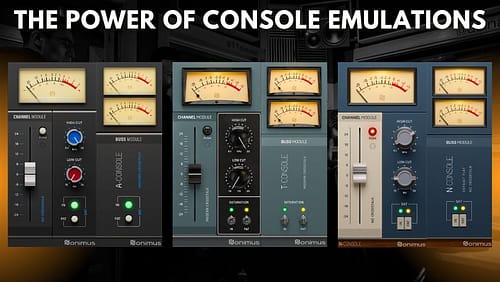One of the most challenging tasks for a mixing engineer is ensuring the mix translates well across different speaker systems. Ensuring the song moves people, whether it’s playing on a stadium’s PA or your phone, is crucial, and a big part of that has to do with the low-end sitting right in the mix. It has to be heard but also felt without being overwhelming or taking over everything else in the mix. But how?
Here are five recommendations to help you achieve a full-body and controlled low-end in your songs.
1- Locate Your Source
Before doing any processing in your tracks, it’s important to locate your low-end sources and decide which one (or ones) will carry the weight of the song. As you would imagine, bass tracks or kicks are usually in charge of that role, so creating the space for them to shine in the mix is important.
We have talked many times about how high-pass filters are great to remove rumble and focus the sound of your instruments, but they also help get the bass to fill its own range in the frequency spectrum. It’s all about finding the crossover point between your bass and the other instruments so they support each other and there are no frequency gaps.
Note that, while synth bass or 808s can be left without filtering, it might be interesting to apply a gentle high-pass filter to acoustic bass drums, since it can help to focus the impact and tone of the drum.
As for low-pass filters… use with caution. Almost everything has high-end information in its spectrum, which might help the bass cut through the mix down the line. Still, consider using them for creative purposes or to make things less noticeable in the mix.
2- Dynamics
Now that we have our low-end sources located, it’s time to keep them “in the pocket”. To achieve this, we need to make them consistent throughout the song, allowing us to control their level with the fader without changing their presence dramatically. How do we do that? You guessed it: compression.
We’ve all heard the eternal dilemma: which comes first, compression or EQ? In the case of bass instruments, I always recommend using compression first to create a consistent performance and then EQ to highlight the qualities of the instrument in a more controlled manner. It also allows us to shape the envelope of the bass or the kick to get more tone and weight out of it.
Fast attacks and fast releases work well on basses, while medium attacks help to control the kicks while keeping the punch intact, but you can experiment with the settings until you get the sound you are looking for. I suggest aiming for no more than five or six dB of gain reduction in this first step. It will ensure a natural sound and leave headroom for extra compression later on.
3- Saturation
Here is where you can make your bass cut through the mix even in small speakers.
Every speaker plays low frequencies. The problem is that small speakers move a smaller amount of air than big cones. That’s why low-end is very poorly presented in small systems unless some design techniques are applied.
By using saturators or distortion in your low-end sources, you can add harmonic content in the high-end of the frequency spectrum. This adds musically related frequencies to the bass being played, which can be reproduced easily by any speaker. That’s how you make your bass audible. A good technique to apply is using parallel processing for the bass, where you create a very saturated version of the bass in a parallel track, clean its low-end, and add it slowly to the mix until you feel it’s starting to pop up. This way, you have independent control over how much of the harmonic content is present in the mix.
4- More Compression, please
Adding serial steps of compression throughout your mixing ensures that your bass sits right in the mix. In this regard, master bus compression is essential to achieve it.
We have talked about master bus compression before. It’s a technique that ensures the cohesion of the whole mix, but most importantly, adds an extra layer of control over the low-end. Since the energy of the bass frequencies is higher than the high frequencies, any over-excess of bass in the mix will trigger the master bus compressor, evening out the whole mix.
5 – Sidechaining
Sidechaining compression in bass, whether by using the built-in sidechain in your compressor to reduce the triggering over low frequencies, or using other instruments to trigger the compressor, is excellent to have more punch in your mix.
A classic example is the use of the kick as a sidechain of the bass to reduce its dynamic every time the kick hits. This effect is well known in ADM and electronic music for creating a pumping effect and enhancing the rhythm section’s beat, but it is also applied in various genres to automate volume drops.
One last tip
Finally, make sure you listen to your mix on different speakers and compare it with your favorite tracks. This will help you get a sense of where the bass sits compared to your track and also listen to how the music translates in different systems. The more you practice these techniques, the more confident you’ll become in handling the low-end in your track.
Do you have any other recommendations to handle the low-end in your mixes? Let us know in the comments, and subscribe to the Sonimus newsletter to get more mixing tips.







Leave A Comment
You must be logged in to post a comment.